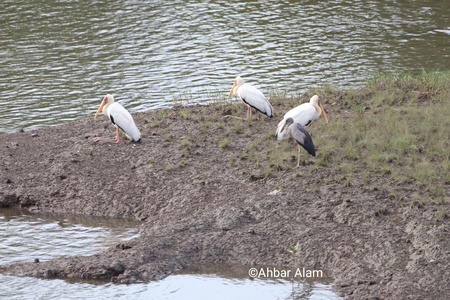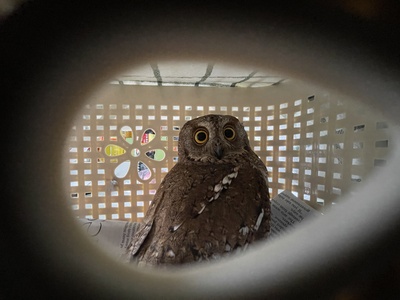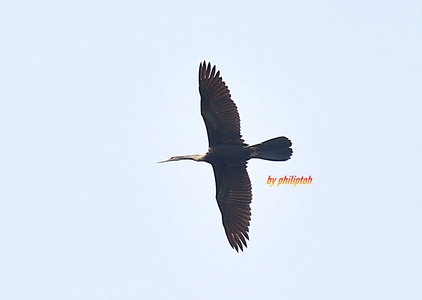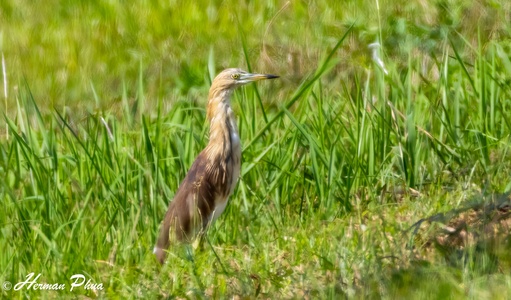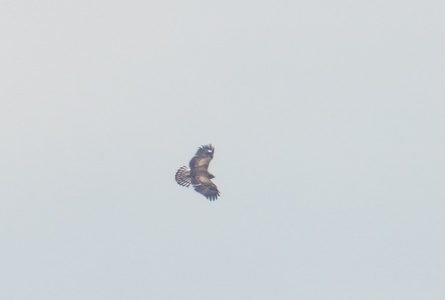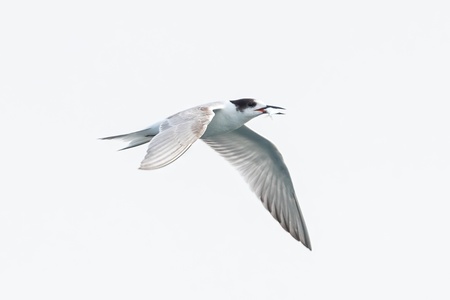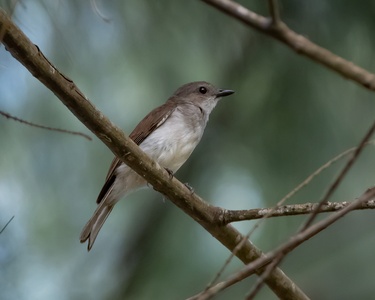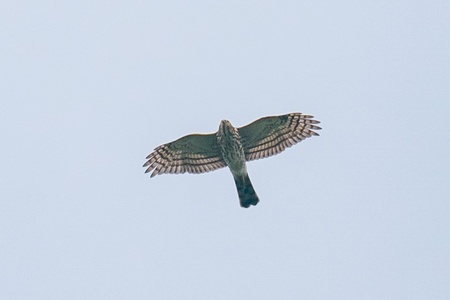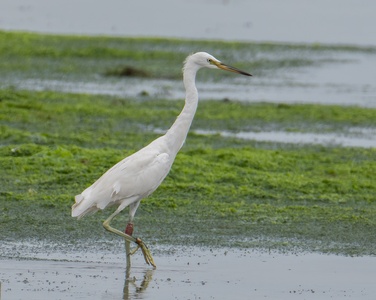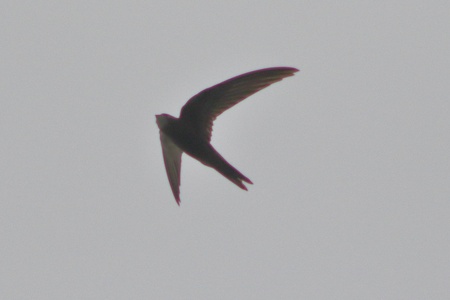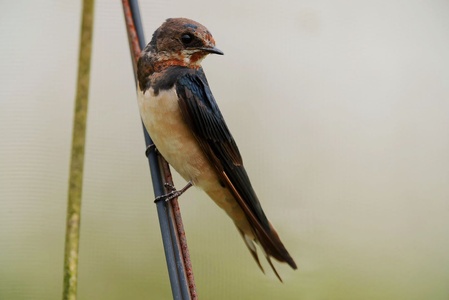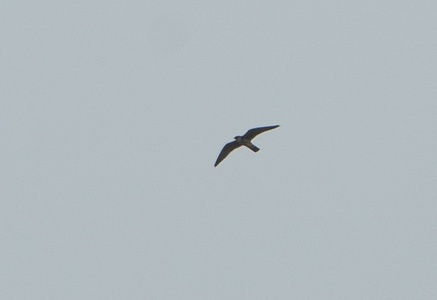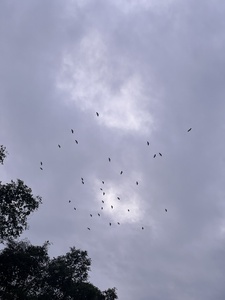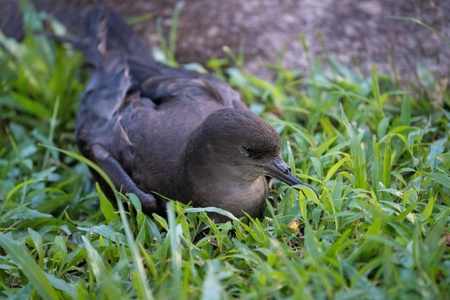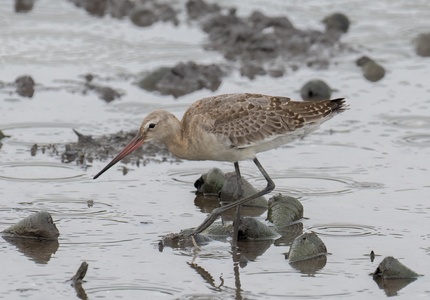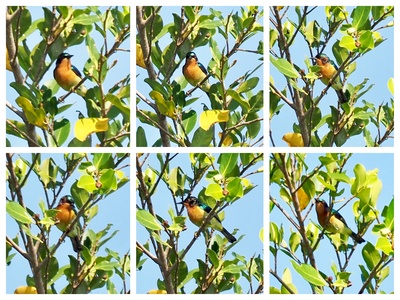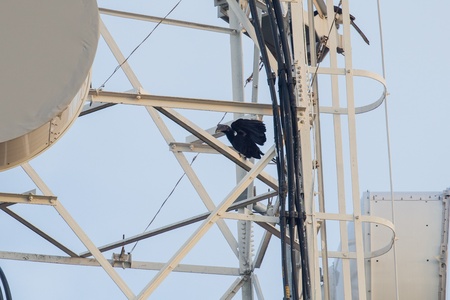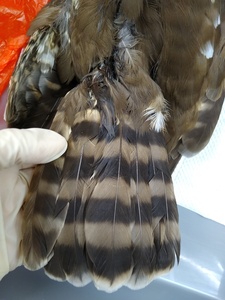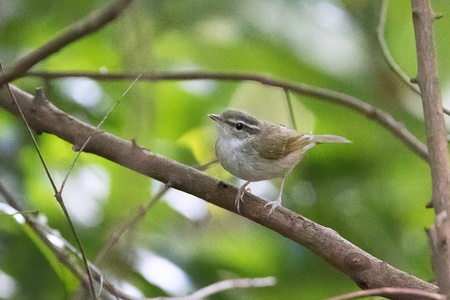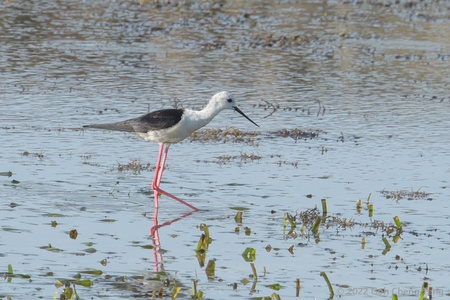| Seen at 0745 with Binoculars, camera (Sony RX-10 MkIV).
I had just started my walk around Bukit Brown, checking the trees in the paddock area which usually contain around 20 species in the early morning, especially parrots, pigeons, bulbuls and starlings. With the naked eye I noticed 2 small birds had perched next to each other on top of a small tree with some naked branches at the top. As I brought the binoculars to my eyes one of the two birds flew off. I focused on the remaining bird and realised it was not a species I had seen before in Singapore, so I took my camera and tried to take a few shots. During this time (around 10 seconds) the second bird flew. Altogether between 1 and 2 minutes at 07.30.
Posture : Upright with body held about 15 degrees off vertical
Size : Approximately Tree Sparrow sized.
Shape: Finch/Bunting shape
No calls heard. The observation period was very short. The birds perched, looked around and flew off. A Tailorbird, Rose-Ringed Parakeet and Yellow-Vented bulbuls were nearby on the same tree but there was no interaction between the species. (see Fig.4)
BARE PARTS: Bill triangular but not too heavy and appeared light in colour, I could not tell the colour of the legs
HEAD: Relatively large and round with slightly peak forehead and slightly shaggy crown. Rosy pink in colour with dark patch/stripe over the eye. Crown appeared a bit darker and slightly peaked.
UPPERPARTS: Dark in colour with no obvious wing patches or tail markings. Tail medium length.
UNDERPARTS: Pink face, neck and breast fading to lighter coloured belly and rump. Underside of tail dark.
IN FLIGHT: Not seen well enough to give a description.
My first thought seeing the birds with the naked eye was that they could be a pair of escapee Peach-Faced Lovebirds which I have seen previously in Singapore. This suggests that the pink colour to the head and breast was very obvious at distance and the dominant feature of the plumage. This also hints to the change in colour from the upper breast to the belly/vent. With the binoculars I could see that they were finches or buntings. The light was poor and the distance was just far enough to make discerning details difficult. As one of the two birds flew I decided to try and get a few photos to help with identification. After only a few quick shots the second bird flew. My time with the birds was limited.
I sent a message to a fellow birder ‘What do you think this is? Some kind of Rosefinch/Chaffinch?’ This was my initial identification in the field. I didn’t get any feedback on the ID but others went to look for the birds the following day and day after when a Black-Thighed Falconet was found in the same location.
Returning home I tried to identify the species using the photos and ascertain the likely origin suspecting that they may be escapees.
Working on the assumption that they were Rosefinches/Finches/Buntings I looked for recent reports on bird markets in Singapore. According to the last Traffic survey of songbirds in Singapore's bird market in 2015 (published 2017) there were no Rosefinches or Buntings for sale in any of the shops. The only small birds for sale with red head/breasts were Red Avadavat (many) and a single Rosy Starling – the birds under discussion clearly do not belong to either of these species.
A further search on Birds Classified Singapore (sg.birdbarter.com) returned no results for Rosefinch or Bunting. A search for ‘Finch’ returned only Zebra Finches and Society Finches. Similarly there were no Rosefinches or Finches (other than Munia) recorded for sale in Jakarta’s bird markets in Traffic’s survey in 2014 (published 2015). Therefore, we can conclude that this family of birds is not sought after as songbirds or merit-release birds in the region, and it appears unlikely that these individuals come from the regular bird trade.
Considering that they could be wild birds I looked through my field guides for likely candidates. Going by the colouration these individuals were males as only the males have the red/rose/pink colouration.
1. Chaffinch (Fringilla coelebs) – Robson lists this species as a vagrant to NW Thailand. It is about the right size but with the absence of wing bars and the even dark colour of the wings and mantle evident in Fig.1 we can discount this species. (It is also a species I am very familiar with)
2. Buntings (Emberiza) – there are no Buntings with this combination of colours. The only species with rufous head colouration is the Red-headed Bunting Emberiza bruniceps but it is brown ad clearly not light red/pink and so can be discounted.
3. Finches – Bill size (too small) and lack of large light wing patch eliminates Hawfinch (Coccothraustes coccothraustes) and lack of black bib and lack of prominent white wing bars eliminate Red-Headed Bullfinch (Pyrrhula erythrocephala)
4. Crossbills and Grosbeaks – combination of bill size and shape eliminates Red Crossbill (Loxia curvivostra) and White-Winged Crossbill (Loxia leucoptera), combination of bill colour and shape eliminates Pine Grosbeak (Pinicola enucleator) otherwise the plumage of the male of this species could be a good match.
5. Crimson-Browed Finch (Propyrrbula subbimachala) – Resident, short-distance migrant and altitudinal migrant in Himalays from Nepal to North Myanmar. Some winter in North-East India. Breeds 3,950m-4,900m and descends to 1,800m to 3,650m in the non-breeding season. This is a bigger-headed and heavier bird than those so far considered and structurally is not a very good match. The plumage is similar but the red on the breast is distinctly red and is a clearly defined zone which ends abruptly at the level of a gorget. I think this species can be eliminated.
6. Dark-Breasted Rosefinch (Procaduelis nipalensis) – Breeds at high altitudes in the Himalayas. Sometimes descends to around 900m in winter. Non-Breeding Visitor/Rare Resident North Myanmar, North Vietnam. Clear contrast between bright pink throat and dark breast visible in all illustrations and photos of the male of this species would eliminate it.
7. Pink-Rumped Rosefinch (Carpodacus waltoni) – Resident and altitudinal migrant in Central & South China (breeds 3950m-4900m). Robson notes it as a vagrant to NW Thailand but this 1968 record is now considered by Birds of the World to be erroneous. The plumage could be a good match but the long notched tail mitigates against this species.
8. Vinaceous Rosefinch (Carpodacus vinaceus) – Resident and altitudinal migrant in C&S China and N&NE Myanmar. Non-Breeding visitor to North India and Nepal. Recent record from North Vietnam (2017). Male plumage overall dark crimson and in the dull light at the time of this observation the birds would have appeared quite dark.
9. Dark-Rumped Rosefinch (Carpodacus edwardsii) – Resident and altitudinal migrant in East Himalayas, North-East India, South-West China and Northern Myanmar. Usually at 3,250m to 4,700m descending to 1,060m in South-West China. Male plumage could potentially look similar in the same light to the birds under discussion here but habitat preferences, distance from nearest population and lack of evidence for long-distance migration and/or vagrancy would mitigate against this species.
10. Spot-Winged Rosefinch (Carpodacus rodopeplus) – Resident in the Himalayas of North India, Nepal and South-West China. Plumage similar to C. edwardsii but restricted range far from Singapore and lack of evidence for long-distance migration or vagrancy would mitigate against this species.
11. Common Rosefinch (Carpodacus erythrinus) - Migratory and partially migratory with large distribution and history of vagrancy. In the region it is a Winter Visitor to Myanmar, N&W Thailand, North Vietnam and Laos. Five subspecies are recognized and 3 of these C. e. grebnitzki, C. e. erythrinus and C. e. roseatus are present in the region.
Conclusion: It is unfortunate that the photos are not good quality as clear images would likely have made positive identification simple and focused the review entirely on likely provenance for these birds.
These birds were possibly on passage and could have passed through Singapore in a single day.
References:
1. In the Market for Extinction, An Inventory of Jakarta’s Bird Markets – Chng, Eaton, Krishnasamy, Shepherd, Nijman – Traffic Report September 2015
2. Songsters of Singapore, An Overview of the Bird Species in Singapore Pet Shops, - Eaton, Leupen, Krishnasamy – Traffic Report February 2017
3. Website – Birds Classified Singapore – sg.birdsbarter.com – consulted 2nd Jan 2022
4. Jurong Bird Park Species list 2019 on www.zoochat.com – consulted 3rd Jan 2022
5. Bird Guide to the Birds of Britain and Europe (Collins) - Mullarney, Svensson, Zetterstrom, Grant (1st Ed. 2001) – pp. 358-359
6. Birds of South-East Asia (New Holland) – Robson (1st Ed. 2005) – pp. 286-293
7. Birds of the Middle East (Princeton) – Porter, Christensen and Hansen (1st Ed. 2004) – pp. 206-222
8. Birds of Nepal with reference to Kashmir and Sikkim (Adarsh) – Fleming, Fleming, Bangdel (3rd Ed. 2000) – pp. 308-319
9. Birds of Hong Kong and South China (HK Govt. publications, 7th Ed. 1996) – Viney, Phillipps, Lam – pp. 206-215
10. A Field Guide to the Birds of China (Oxford) – MacKinnon, Phillipps (1st Ed. 2000) – plates 120-128 and pp. 497-532
11. Birds of the Indonesian Archipelago Greater Sundas and Wallacea (Lynx) – (1st Ed. 2016) – pp. 472-473
12. Birds of the Western Palearctic Concise Edition, Volume 2 Passerines (OUP) – Snow, Perrins (1st Ed. 1998) pp. 1596-1606
13. Birds of East Asia (Helm) – Brazil (1st Ed. 2009 reprinted 2012) pp. 470-476
14. Website – eBird – www.ebird.org (Cornell Lab of Ornithology)
15. Website – Birds of the World – www.birdsoftheworld.org (Cornell Lab of Ornithology)
16. The Avifauna of Singapore (NSS) – Lim Kim Seng (2009) |
